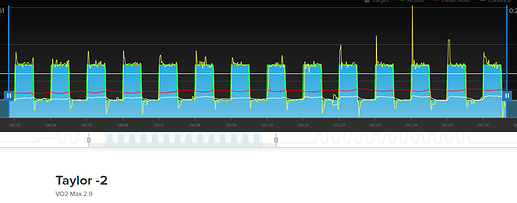A lot of topics hit home with me today and thank you all for a great episode ![]()
I had one question stemming from this podcast.
In response to Carson’s question about developing as a racer there were recommendations to train the snap in order to help when establishing breakaways and winning races etc.
However, it feels to me that this is an area that is under-targeted in lots of the road race/crit/short power parts of the plans with lots of repeats of work in the 100-140% range but very little at 150-200% which is what I’d imagine is needed in a “snap”?
Does Carson need to do something additional and specific on top of what the plans already include or is it assumed that just by doing lots of accelerations in training to 130/140% that you are building the right muscle adaptations that will make going to 170% in a race breakaway that much easier?
In the quick discussion on erg mode versus resistance mode, I don’t think I heard any talk about the slow response time of smart trainers while in erg mode. When performing short intervals, the response time to settle into the target wattage can be 10 second while in erg mode. Using Resistance mode, specifically on short intervals, allows a much faster response and puts you at the target wattage for a longer percentage of the time than erg mode,.
My 2 cents
That ERG mode response depends on a number of factors.
-
The trainer in question matters most, because some handle those step changes faster and better than others. Particularly, the top shelf trainers like the Kickr, Neo and even H3 snap to higher and lower power in 1-3 seconds based on my testing. I’ve been able to apply these even with short/short intervals like 30/30 as well as 15/15 with good results. That said, some trainers (cough Elite cough) are much slower to respond and are not ideal for these sharp workout steps and short duration.
-
Next in line is likely gearing in use. Most smart trainers perform step changes faster and more firmly when the trainer is spinning slow. Specifically using a 34t ring vs a 50t ring on the front (typical road bike) allows the trainer to adjust resistance level faster and firmer. A faster spinning flywheel has more inertia, and therefore makes applying resistance changes more taxing on the trainer resistance unit.
-
Finally, and potentially equal to those above is the rider. Key in best ERG use is CADENCE. Holding steading cadence in most use allows the trainer and app to give the best ERG experience. When looking at large changes in power, the rider has an important part to play.
-
They roll into an interval at a given cadence, the app & trainer apply a resistance change based upon that existing cadence, and the power kicks up as a result. What matters in this critical moment of transition of resistance is that the rider holds that same cadence relatively steady. If they bog down to a slower cadence, which is common when the trainer resistance “bites”, it leads to a drop in relative power and delay in hitting the planned power target. So, at the very least, the rider should do their best to limit cadence drops to a couple of rpm if at all possible. Doing so will let the trainer pick up the resistance based upon a constant and known cadence value.
-
Knowing the tendency for this cadence drop and affect the intro to intervals, I have adopted a general practice with short kicks like this. I usually drop my cadence 5-10 rpm in the last 30 seconds or so approaching the 1st kick interval. I wait until the trainer “bites” at about 1 second before the official interval time (since TR sends the resistance change a moment early in attempt to help with the trainer lag issue) and I kick my cadence hard back up that 5-10 rpm I drop at a minimum.
-
This “boost” actually ends up “helping” apply power towards the target because the resistance unit was in a “tighter” setting prior to the interval change. For most of these types of intervals, that are often well over Threshold, I am usually going from my deliberate low cadence around 90 rpm, and jumping hard to 105 rpm or so. That final rpm varies with respect to the power level and pending duration. I will tend toward higher for shorter and higher intervals.
-
And in the recovery intervals, as is common, I lower my cadence 5-15 rpm as part of the recovery. This helps me get ready physically, but also “resets” to a lower cadence to then apply the “kick start” of my cadence increase mentioned above. Rinse and repeat until completion of the interval.
-
This “trick” may or may not work for all trainers, but it works well on the 3 biggies I mention above and the time I’ve also had on lower level trainers like the old CycleOps PowerBeam, Tacx Vortex and Wahoo Snap.
I am all for people switching to RES or STD mode if they like for short/shorts or any other workouts the prefer. But ERG can be leveraged to work well with these in the right mix for those that want to give them a try.
Edit to add a few pics of intervals with this practice in use.
- ERG mode, 34t x 17t gearing, Kickr17 trainer:
and then my brain tells my legs to dump more power into the pedals. “Modulating power” at the pedals a skill you can learn, its more of a neuromuscular or mind/body skill, and it comes in handy both outside and inside.
Taylor -3 with smooth off/on and on/off transitions. Very small changes in cadence.
Kickr 2017 with high gearing chainring and Kickr flywheel “speed” is 28mph so probably 50x13 or 50x14 or something.
Great looking example there.



